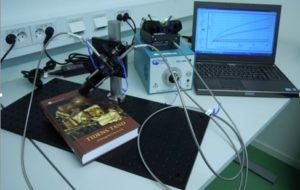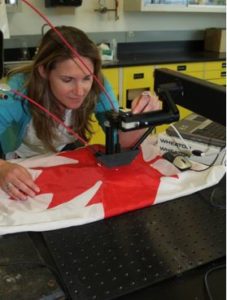
 Dr Judith Bannerman (Technical Services Manager for EMPS Labs) was invited to speak on Ada Lovelace day at the Sidmouth Science festival on Tuesday 10th of October. The title of the talk was ‘Micro-fade Testing: From Dyed Porcupine Quills to Paintings’. The talk explored using engineering analytical techniques to look at artwork and issues in conservation of museum objects in order to preserve them for generations to come.
Dr Judith Bannerman (Technical Services Manager for EMPS Labs) was invited to speak on Ada Lovelace day at the Sidmouth Science festival on Tuesday 10th of October. The title of the talk was ‘Micro-fade Testing: From Dyed Porcupine Quills to Paintings’. The talk explored using engineering analytical techniques to look at artwork and issues in conservation of museum objects in order to preserve them for generations to come.
One of the biggest issues in cultural heritage and museums is the display of objects and protecting them for future generations to enjoy. Objects from dyed porcupine quills to paintings can display a range of light sensitivities to display lighting, storage or even photography. Traditionally we have used blue wool cards to predict the dosage of light that an object is being exposed to on display but we rarely monitor objects when off display and in other situations. The other issue with blue wool cards is the damage is already done when we start to see fading on the blue wool card and so we limit display times of objects or choose not to display them at all. What if we could predict how long an object could be on display, what lighting levels would be ideal, all before an object was exposed to light? Micro-fade testing was invented by Paul Whitmore to do just that. It uses a very small spot of light, 3mm or less, so it can be used on the dot at the end of a sentence in the Dead Sea Scrolls, and collects data on the fade rate of that spot and predicts forward the rate at which an object will fade at a specific lighting level. The lighting level can then be changed in the free, light exposure software from the Canadian Conservation Institute in order to extend the life of an object and help museums make important display decisions. It has even been reverse engineered to help conservators to clean graffiti from a photograph on PVC canvas. We have only just scratched the surface for the number and types of objects that have been used in this machine and predict that it will become an affordable and essential piece of equipment for the modern museum to make display decisions that will protect objects for the future whilst allowing audiences to enjoy and learn from the objects of their past.
Future plans are to build one here in Exeter and start exploring what else this machine can do in other fields such as removal of tattoos, recycling and breakdown of plastics, printer ink stability, or further developing this machine to incorporate chemical analysis to look at the changes occurring during exposure. She has also been invited to speak at the next Southwest Conservators meeting at the RAAM in January 2018. Watch this space as ‘Technicians made this happen’!

